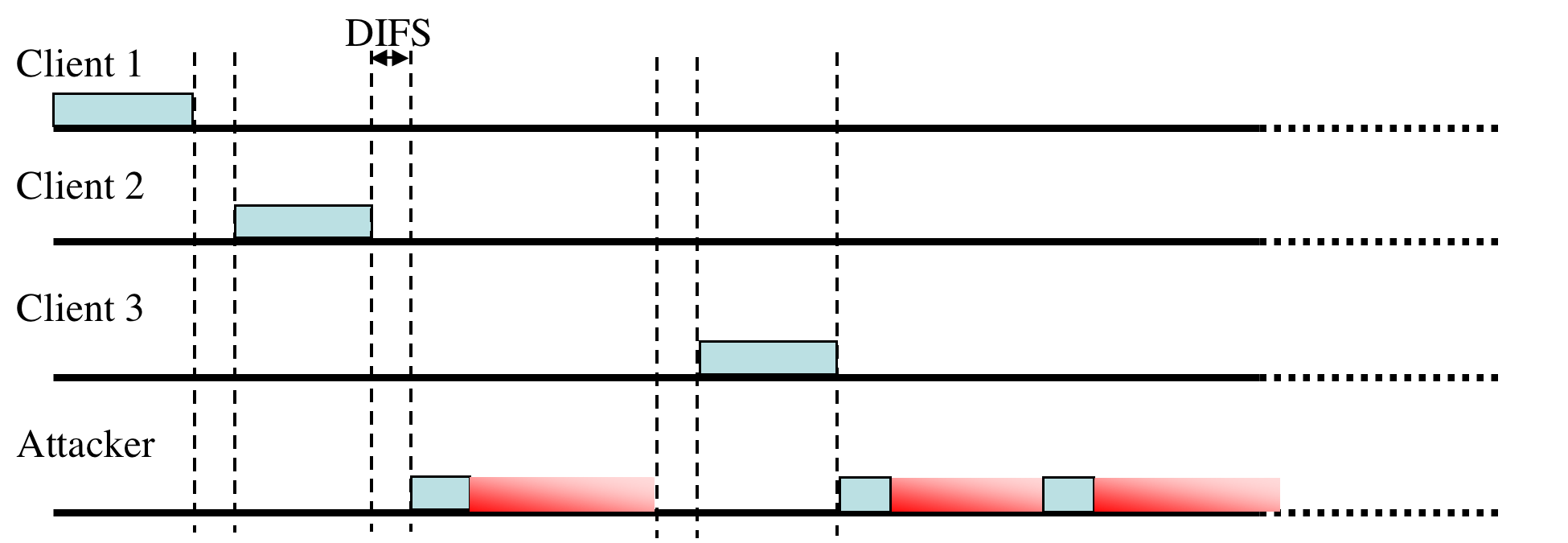
|

|
802.11 networks go through significant effort to avoid transmit collisions. Due to hidden terminals perfect collision detection is not possible and a combination of physical carrier-sense and virtual carrier-sense mechanisms are employed in tandem to control access to the channel [BDSZ94]. Both of these mechanisms may be exploited by an attacker.
First, to prioritize access to the radio medium four time windows are defined. For the purposes of this discussion only two are important: the Short Interframe Space (SIFS) and the longer Distributed Coordination Function Interframe Space (DIFS). Before any frame can be sent the sending radio must observe a quiet medium for one of the defined window periods. The SIFS window is used for frames sent as part of a preexisting frame exchange (for example, the explicit ACK frame sent in response to a previously transmitted data frame). The DIFS window is used for nodes wishing to initiate a new frame exchange. To avoid all nodes transmitting immediately after the DIFS expires, the time after the DIFS is subdivided into slots. Each transmitting node randomly and with equal probability picks a slot in which to start transmitting. If a collision does occur (indicated implicitly by the lack of an immediate acknowledgment), the sender uses a random exponential backoff algorithm before retransmitting.
Since every transmitting node must wait at least an SIFS interval, if not longer, an attacker may completely monopolize the channel by sending a short signal before the end of every SIFS period. While this attack would likely be highly effective, it also requires the attacker to expend considerable energy. A SIFS period is only 20 microseconds on 802.11b networks, leading to a duty cycle of 50,000 packets per second in order to disable all access to the network.
A more serious vulnerability arises from the virtual carrier-sense mechanism used to mitigate collisions from hidden terminals. Each 802.11 frame carries a Duration field that indicates the number of microseconds that the channel is reserved. This value, in turn, is used to program the Network Allocation Vector (NAV) on each node. Only when a node's NAV reaches 0 is it allowed to transmit. This feature is principally used by the explicit request to send (RTS) / clear to send (CTS) handshake that can be used to synchronize access to the channel when a hidden terminal may be interfering with transmissions.
During this handshake the sending node first sends a small RTS frame that includes a duration large enough to complete the RTS/CTS sequence - including the CTS frame, the data frame, and the subsequent acknowledgment frame. The destination node replies to the RTS with a CTS, containing a new duration field updated to account for the time already elapsed during the sequence. After the CTS is sent, every node in radio range of either the sending or receiving node will have updated their NAV and will defer all transmissions for the duration of the future transaction. While the RTS/CTS feature is rarely used in practice, respecting the virtual carrier-sense function indicated by the duration field is mandatory in all 802.11 implementations.
An attacker may exploit this feature by asserting a large duration field, thereby preventing well-behaved clients from gaining access to the channel (as shown in Figure 2). While it is possible to use almost any frame type to control the NAV, including an ACK, using the RTS has some advantages. Since a well-behaved node will always respond to RTS with a CTS, an attacker may co-opt legitimate nodes to propagate the attack further than it could on its own. Moreover, this approach allows an attacker to transmit with extremely low power or using a directional antennae, thereby reducing the probability of being located.
The maximum value for the NAV is 32767, or roughly 32 milliseconds on 802.11b networks, so in principal an attacker need only transmit approximately 30 times a second to jam all access to the channel. Finally, it is worth noting that RTS, CTS and ACK frames are not authenticated in any current or upcoming 802.11 standard. However, even if they were authenticated, this would only provide non-repudiation since, by design, the virtual-carrier sense feature impacts all nodes on the same channel.
John Bellado 2003-05-16